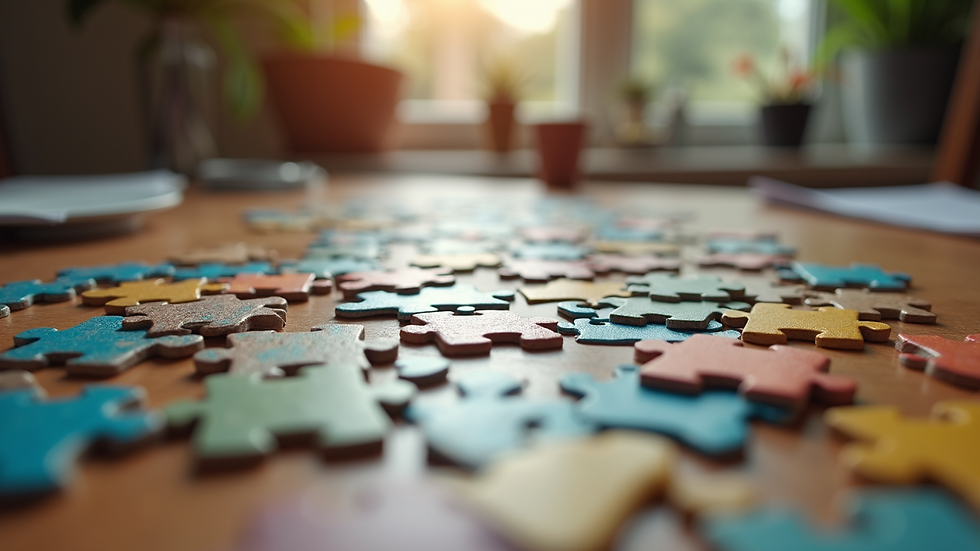Top 10 Puzzle Strategies for Beginners
- lslatt20001
- Nov 3
- 3 min read
Puzzles can be both fun and challenging, but starting out can feel overwhelming. Many beginners struggle with where to begin or how to approach different types of puzzles. The good news is that there are clear strategies that can make solving puzzles easier and more enjoyable. Whether you enjoy jigsaw puzzles, logic puzzles, or brain teasers, these top 10 strategies will help you build confidence and improve your skills.

1. Understand the Puzzle Type
Before diving in, take a moment to understand what kind of puzzle you are facing. Different puzzles require different approaches:
Jigsaw puzzles focus on matching shapes and colors.
Logic puzzles require reasoning and deduction.
Word puzzles involve vocabulary and pattern recognition.
Knowing the puzzle type helps you choose the right tools and mindset. For example, a Sudoku puzzle needs number placement logic, while a crossword puzzle depends on word knowledge.
2. Start with the Edges or Corners
For jigsaw puzzles, begin by finding and assembling the edge pieces. These pieces have at least one straight side, making them easier to identify. Building the border creates a frame that helps you organize the rest of the pieces.
This approach applies to other puzzles too. For example, in a maze puzzle, start by identifying the entrance and exit points before exploring the path.
3. Break the Puzzle into Sections
Large puzzles can feel overwhelming. Divide the puzzle into smaller, manageable sections. For jigsaw puzzles, group pieces by color or pattern. For logic puzzles, break down the problem into smaller parts.
This method helps you focus on one area at a time, reducing frustration and making progress more visible.
4. Look for Patterns and Clues
Many puzzles rely on patterns. Pay attention to repeating shapes, colors, or sequences. In word puzzles, look for common prefixes, suffixes, or letter combinations. In logic puzzles, identify rules or constraints that limit possibilities.
Recognizing patterns speeds up solving and helps avoid random guessing.
5. Use the Process of Elimination
When unsure about a piece or answer, eliminate options that clearly do not fit. This strategy narrows down choices and increases the chance of selecting the correct solution.
For example, in Sudoku, if a number cannot appear in certain rows or columns, cross those out to focus on valid placements.
6. Keep Your Workspace Organized
A tidy workspace helps you see all your pieces or clues clearly. Spread out puzzle pieces or notes so nothing is hidden. Organize pieces by type, color, or size.
An organized area reduces mistakes and saves time searching for missing parts.
7. Take Breaks and Return with Fresh Eyes
If you get stuck, step away for a few minutes or hours. Returning with fresh eyes often reveals new insights or solutions you missed before.
Breaks prevent frustration and keep your mind sharp.
8. Practice Regularly to Build Skills
Like any skill, puzzle solving improves with practice. Try different types of puzzles to develop a range of strategies. Over time, you will recognize common patterns and improve your speed.
Set aside time each week to challenge yourself with new puzzles.
9. Use Tools and Resources Wisely
Some puzzles allow or benefit from tools such as pencils, erasers, or apps. For example, lightly marking possible answers in a Sudoku puzzle helps track options. Online resources can provide hints or tutorials for tricky puzzles.
Use tools to support your thinking, not replace it.
10. Stay Patient and Enjoy the Process
Puzzles are meant to be enjoyable challenges. Don’t rush or get discouraged by mistakes. Celebrate small victories and learn from errors.
Patience and a positive attitude make puzzle solving more rewarding and fun.
By applying these strategies, beginners can approach puzzles with confidence and improve their skills steadily. Start with simple puzzles, use these tips, and watch your problem-solving abilities grow. The next time you pick up a puzzle, remember that success comes from clear thinking, organization, and persistence. Happy puzzling!


Comments